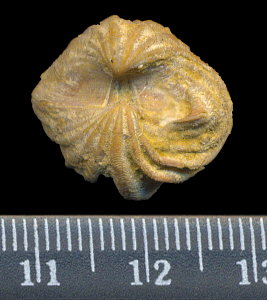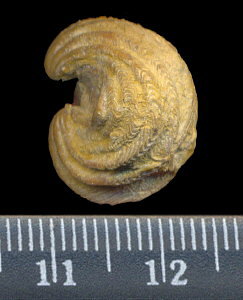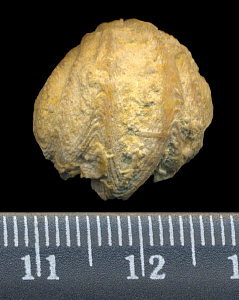Paraspiriferina sp.
Click on pictures to magnify
Discussion:
This species has a rounded outline, regular small
growth lamellae,
large radial plications with rounded crests, a larger median fold
than lateral plications and large interarea with a large overhang of
the beak. This species and similar ones of Permian age have
traditionally been placed in the genus Callispirina in the Russian
literature, but the species illustrated here is best assigned to the
genus Paraspiriferina. Paraspiriferina differs from Callispirina
in
having rounded tops on the plications rather than sharp tops and in
having a median fold that is notably higher and wider than any
lateral costae (see Cooper & Grant, 1976). Also, Callispirina lacks
any hollow spines or pustules on the growth lamellae. Close
examination of the species shown here reveals the presence of
pustules and the plications are clearly rounded instead of sharp.
The specimen illustrated here is very well preserved, so the
identification seems valid.
Callispirina is a middle and late Permian genus
and appears to be
an uncommon genus in Permian biotas. An occurrence in the latest
Carboniferous would be a major range extension. In contrast,
Paraspiriferina is known to range through the Permian and down to the
base of the Permian, so an occurrence in the Gzhelian would not be
surprising. Paraspiriferina is a relatively common genus and includes
larger species than Callispirina. The Gzhelian species is 2 cm wide,
larger
than Eurasian specimens identified as Callispirina (see Kalashnikov,
1998).


